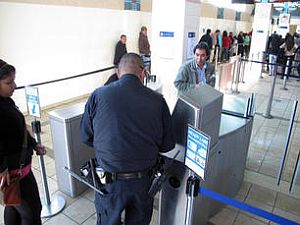El Paso, Texas — Under the desert sun at the Paso del Norte bridge between Ciudad Juarez in Mexico and El Paso, Texas, hundreds of pedestrians stand in line for up to two hours to reach the immigration booths.
Not Veronica Escobar. She, like almost a third of the nearly 14,000 people who walk daily across the bridge that connects the border towns' downtown areas, uses a radio frequency-equipped ID (RFID) card to access the ready lanes installed last November for persons crossing the border on foot.
The program, implemented by Customs and Border Protection to make it quicker for pedestrians to enter the U.S. from Mexico, has reduced wait times by 26 percent at this West Texas crossing. Travelers swipe their cards or machine-readable documents, such as a US passport, and as they wait, their personal information is retrieved from a database and sent to immigration agents. The process can trim up to 6 seconds per person.
Escobar, 41, crosses from Juarez every other week to go shopping.
"Before, when I didn't know that I could use these lanes, I would stand in line for up to three hours. Today, it was just 20 minutes," Escobar said.
Jesus del Rio, 48, made the same discovery Friday. He was recently issued a RFID visa card, but didn't know about the new quick lanes. After a two-hour wait, he was informed he could have walked to the gates inside the Point of Entry main building.
"This is the last time I stand in the long line," he said after a CBP officer showed him how to use the gate.
Customs and Borders Protection spokesman Roger Maier said Friday that future studies will determine whether the project at the Paso del Norte bridge expands to other U.S. border crossings.
In an effort to further expedite the process, high-visibility LED signs were installed in November over vehicle lanes in the El Paso area and, on Friday, short-distance AM radio stations started broadcasting traveler information near the El Paso and Laredo bridges.


